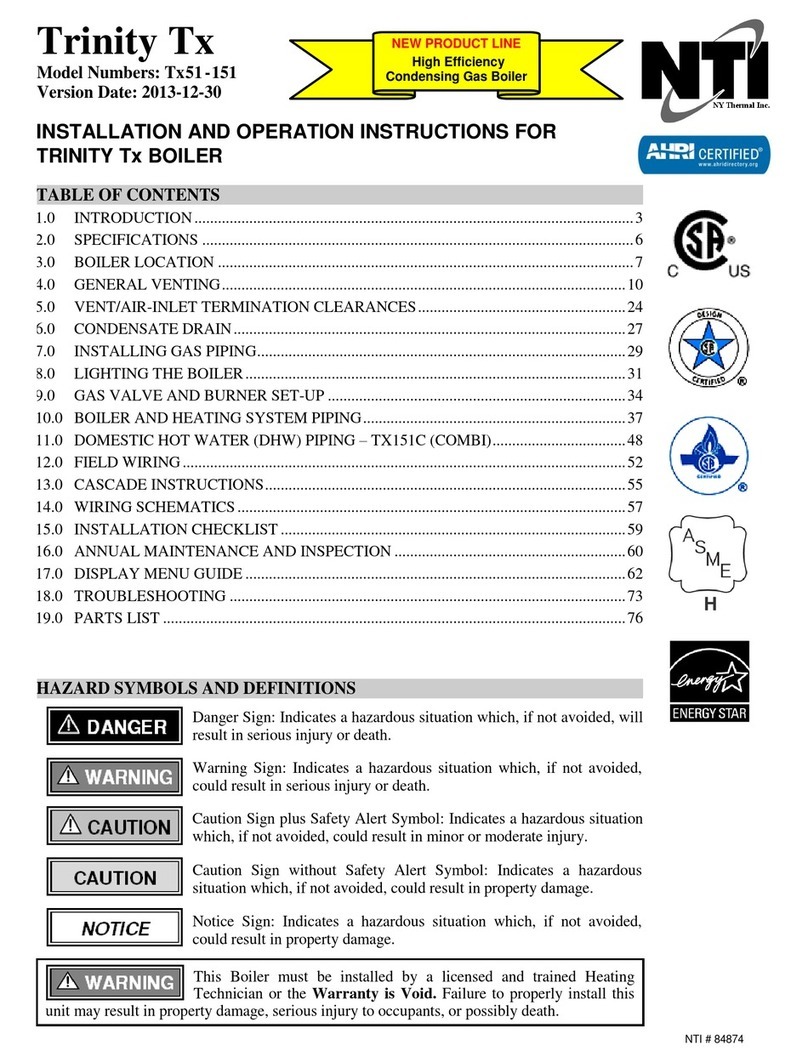
4
3. The horizontal distance between the inlet and exhaust must be a minimum of 4” center to center.
If the horizontal distance between the inlet and exhaust is more then 12”, increase the vertical
separation by the same amount. Example: If horizontal separation is 24”, a minimum vertical
separation of 30” is required (24”-12”=12”), so increase minimum vertical separation by 12”),
(18”+12”=30”). If horizontal distance is greater then 6’, no additional vertical spacing is required.
Vertical separation is never required to be greater then 36”.
4. Under normal operating conditions this appliance will produce a plume of white gases, and
should be taken into consideration when selecting an adequate location. A 3’ diameter stainless,
plastic, or vinyl shield can be used to flash the exterior of the residence.
The vent terminal shall not terminate:
• Directly above a paved sidewalk or a paved
driveway that is located between two
buildings, and that serves both buildings;
• Less than 7 feet above grade where located
adjacent to a paved driveway or public walkway.
• Within 3' (three feet) horizontally of a window or door that can be opened, or non-mechanical air
supply inlet to any building.
• Within 6’ of a mechanical air supply inlet to any building, or roof eve containing soffit openings.
• Above a meter/regulator assembly within 3' horizontally of the vertical centerline of the regulator.
• Within 6' of any gas service regulator vent outlet.
• Less than 30” plus snow allowance above grade, or any surface that will support snow, ice, or
debris. The exhaust must be a minimum of 18” above the air inlet, and the air inlet must
always be a minimum of 12” plus snow allowance above any surface that will support
snow. (Two feet plus snow allowance is highly recommended). Consult your weather
office, for the maximum typical snowfall for your region.
• Underneath a wooden verandah, porch, or deck.
• Underneath cement verandah, porch, or deck, unless both ends are open and the exhaust pipe
is installed at least 24” under the deck floor.
• So situated that the flue gases are directed towards brickwork, siding, or other construction, in
such a manner that may cause damage from heat or condensate from the flue gases
• Less than 3’ from an inside corner of an L-shaped structure (including walls and fences).
3.3 VENTING CONFIGURATIONS
Selection of acceptable venting materials is as follows.
Vent Piping A -C: See Chart for maximum lengths
• 2” or 3” ABS solid core.
• 2” or 3” PVC schedule 40 pipe.
• 2” or 3” CPVC schedule 40 pipe.
• 3” AL29-4C flex Stainless vent
• 3” AL29-4C Rigid Stainless Vent.
Air Supply Vent B: See Chart for maximum lengths
• 2” or 3” ABS.
• 2” or 3” PVC schedule 40 pipe.
• 3” Galvanized Steel pipe
• 3” Flex Aluminum (MAX 20’)
These are code restrictions for the location
of the Flue gas vent terminal. Compliance
doesn’t insure a satisfactory installation;
good common sense must also be applied.
Warning
Field supplied piping and fittings are required to
complete installation. The combustion air and
vent pipe and fittings must conform to ANSI and
ASTM standard D1785 (schedule 40 PVC),
D2665 (PVC-DWV), and D2661 (ABS-DWV).
Pipe cement and primer must conform to ASTM
standard D2564 (PVC) or D2235 (ABS).
Warning
Never mix 2” and 3” pipe in the same installation.
(All 2” or all 3”)




























